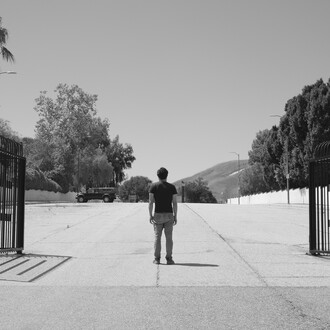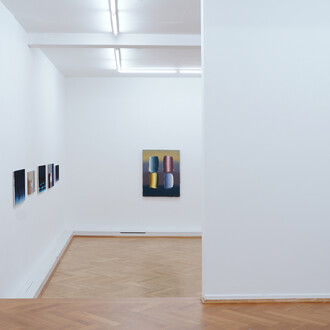Visitors might get the impression that Johanna Dumet has invited them into her own home—the artist has covered the walls of Mehdi Chouakri Gallery with hundreds of paintings that, in combination, evoke the illusion of a gigantic interior scene. At first glance through the gallery window, the pink residence may seem unfamiliarly extravagant, but our childlike curiosity and latent voyeurism reveal themselves as we explore the life-size setting.
In 1947, Henri Matisse painted Intérieur rouge, nature morte sur table bleue. The painting depicts a red room with a round table on which one can see fruit and a vase of flowers; an open terrace door offers a view of the greenery outside. In this colourful painting, Matisse merged the interior view of the room with a still life. Johanna Dumet references this famous artwork and takes it to the extreme by making pink the dominant colour and expanding the work to such an extent that it takes up the entire gallery space. The dazzling pink, in an array of shades, is the artist's favourite colour. Her use of the often ridiculed and underestimated colour pink represents a conscious confrontation with prejudices and unspoken rules in the art world. Simultaneously, the artist's demonstrative use of space is a gesture long believed to be reserved primarily for male artists in art history.
Piece by piece, as if gradually creating a fresco, Dumet painted hundreds of paper cut-outs with oil paint before compiling them. It is no coincidence that the individual parts have different sizes and that the transitions appear rough at times: >"Imperfection is my favourite thing to happen," comments the artist. Dumet worked on the individual puzzle pieces for weeks, and different styles reveal her mood at the time. Sometimes, the brushwork is meticulous and rich in detail, while at other times, one sees a rapid painterly execution on the surface. Despite the painting's two-dimensionality, numerous angles allow spaces to appear almost three-dimensional.
The artist intends Intérieur rose to represent a place of well-being. To furnish one's own home according to individual taste is a basic human need, as it provides a sense of security and safety. With "Intérieur rose", Dumet allows visitors to experience her creation of an interior. She deliberately chose the furnishings to achieve an atmosphere in which to feel uninhibitedly like a child. And indeed, a sense of playful curiosity does arise when exploring the vivid environment. Several artworks—pictures within the picture—adorn the walls, including works by Dumet and paintings by other artists. Somewhere in the pink ambience, not far from a Greek marble statue, a grey cat thoughtfully overlooks the situation. The bottom of a staircase is hinted at, yet where it leads is left to one's imagination. Similarly, the view into an adjoining room with eerily indistinct furnishings remains barely outlined.
The exhibition's key work—literally—also allows for speculation because, amid all the considerably larger paintings, the inconspicuous keyhole is easy to miss. Glancing through it, one gets a vague idea of the events unfolding behind the closed door. Here you see the only people far and wide. The scene brings to mind Marcel Duchamp's walk-in sculpture "Étant donnés" (1946-66), wherein glancing through the keyhole reveals a naked female body. Compared to Duchamp, however, Dumet's installation shows far less. Whether or not this is a lovemaking scene remains unanswered, and the identities of those involved are undisclosed. But the voyeuristic gaze does expose the viewer’s expectations: What does the alluring view promise? To what extent are we reluctant to spy on someone's home?
Not only does Johanna Dumet merge the still life and the interior in the same way as Matisse once did, but she also draws on the tradition of the genre picture. These depictions of seemingly ordinary everyday situations, popular from the 15th century onwards, contain subtle hints or secret codes only to be found upon close inspection. Furthermore, they often entailed a moral message, which, in this case, might be: "Be curious! Peek through keyholes! Snoop around!"
The artist turns the gallery into her own chamber play. In this gigantic setting, the visitors gradually transform into performers. Just like in a theatre play, they take on specific roles: the reserved one, the attentive observer, or the curious snoop. The gallery becomes a stage—what may seem private or clandestine occurs in full public view and is observable through the gallery windows. The immersive painting of "Intérieur rose" is simultaneously playful and accessible but can also be challenging. After all, the script is unknown, and the ending is open.
(Text by Julia Meyer-Brehm, translation by Katerine Niedinger)
















